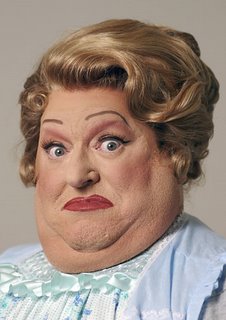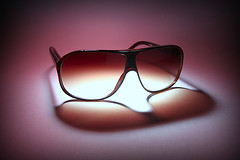 Okay, show of hands: How many people have been trying to do this Lighting 102 stuff with just one flash?
Okay, show of hands: How many people have been trying to do this Lighting 102 stuff with just one flash?Don't feel so bad. Back in the day, lighting guru Dean Collins was only allowed to use one light source for his first year of studying his craft at school. And he did just fine, thank you.
Whether you have one light or twelve, the trick is making them look like more is knowing how to stretch them into doing double-, triple- and even quadruple-duty for you. Or you can just take that one light and give it some texture -- a little more interestingness.
By reflecting and refracting light, you can pimp it up like a college student making a gourmet meal out of ramen noodles and a few Taco Bell fire sauce packets. Hit the jump for more.
________________________
For the most part, light from your flash starts out looking pretty yucky. We have learned how to move it around, soften it up and restrict it, but you can also bend it, or shoot it right back at itself.
In fact, before the light ever leaves your speedlight, it has already been refracted. The fresnel lens on the front of your strobe bends the rays to make them spread out wide or zoom in tight. But who's to say that you can't do a little more of that kind of stuff after the fact?
 At left is a photo of photographer Ant Upton, who did this cool guest On Assignment of a soccer player in Paris a ways back. I shot him during a lighting seminar in London last year.
At left is a photo of photographer Ant Upton, who did this cool guest On Assignment of a soccer player in Paris a ways back. I shot him during a lighting seminar in London last year.Before we lit it, the backdrop for this photo was an speckled grey room divider. A gelled flash took care of the drab color. But the subtle pattern was created by shooting our background flash through a water pitcher to bend the light around in a funky way.
This is the kind of thing that can turn a plain-jane background into something with a little texture to it. I do these lighting gigs in typical, boring hotel conference rooms, and I often have to scrounge for something to make the light a little more interesting. I have to go with what I have on hand, and frequently, that means a stack of water glasses or a pitcher.
In this instance, the trick is to back the flash up a little from the pitcher to make the light point-source enough to create a good pattern as it shoots through. (This also means you are probably gonna get a lot of spill around the pitcher, so I tend to snoot or grid the light to keep the beam tight.)
If you are looking for an even cooler thing to shoot light through, those (cheap) translucent, wavy-glass blocks at Home Depot look even nicer for a light bender. Use your imagination -- light modifiers are everywhere.
________________________
 Or, you can easily make one light do the work of two. For this quickie headshot-in-a-corner of actor Bruce Vilanch (in drag for a role in the musical "Hairspray," I stuck a speedlight into an umbrella and used one wall of the corner setting for a backdrop and the other wall as a reflector.
Or, you can easily make one light do the work of two. For this quickie headshot-in-a-corner of actor Bruce Vilanch (in drag for a role in the musical "Hairspray," I stuck a speedlight into an umbrella and used one wall of the corner setting for a backdrop and the other wall as a reflector. Bingo: One light becomes main and fill.
(Full how-to on the quickie corner headhot setup here.)
This is simple stuff, and you should always think of a neutral-colored wall as a second light source, waiting to help you fill those shadows.
But refracting light can make it more interesting, and reflecting light can multiply it into something that looks far more complex than it is.
 For instance, you can shoot light through something translucent and use the resulting modulated shadow as a compositional element. A good example is this shot of a pair of glasses, by Ekistoflarex.
For instance, you can shoot light through something translucent and use the resulting modulated shadow as a compositional element. A good example is this shot of a pair of glasses, by Ekistoflarex. All it takes is a little imagination.
________________________
But especially nifty, IMO, is what you can do with mirrors. And rather than throw an example up for this, I want you to take a moment to previsualize it. This way, you start to build a photo in your mind before you pull out the first (and sometimes only) light.
You want to get to where you can see the light in your mind before you ever start to create it. You want a process you can depend on, not a string of lucky accidents. (Although we'll certainly take lucky accidents when we can get them.)
Imagine a table-top product shot, lit with a single, bare light, say, from directly above. You'd obviously get that "suspect-getting-the-third-degree" kind of light. Which can be cool, depending on the reflective quality of the surface the object it is sitting on.
But say, for the sake of argument, that you happened to drop by Ikea or a home store and bought a pack of four mirror tiles for $5.99.
Now, say you placed two mirrors front camera left and right of the subject, and the other two back camera left and right, too. If you angled them properly, you would turn that one, top-spotlight into a full, five-sided wrap-light setup for just $5.99.
You seeing it?
In fact, you can do a lot of seemingly complex table-top photography with just one real light source, if you bounce that thing around some. That mirror-wrap thing is just an example. You might decide to build your lighting scheme on one (real) rim light with reflector cards and mirrors stretching it into a near-endless set of apparent light sources.
If you are into gelling your light, you could control the color of each of those mirrored light sources individually. You just have to remember that you'll get double the strength out of your gels, because the light gets gelled on the way in and on the way back out when reflecting from the mirror.
(It's an easy fix. You just use half of what you need -- a 1/2 CTO becomes a full CTO, etc.)
If $5.99 is beyond your disposable income limit this week, consider making some foil reflectors. Just a little cardboard covered with aluminum foil can do winders for a small product shot. Remember to crinkle the foil up, then spread it back out, for a nice, even reflector surface.
No assignment today -- just some thoughts to get your gears turning. Just a heads-up to be thinking about what you have -- or can scrounge or buy -- as a set of reflectors. Because our next assignment (which I'll be doing, too) will require that you use one light -- in several different directions at once.
NEXT: 5.2: Assignment | Double-Duty Light




0 comments:
Post a Comment